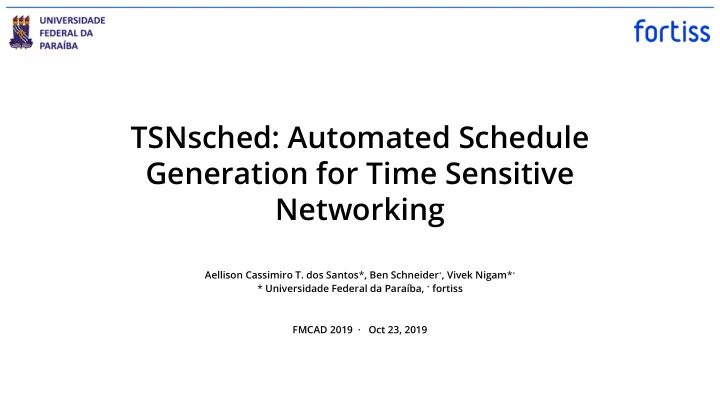

TSNsched: Automated Schedule Generation for Time Sensitive Networking Aellison Cassimiro T. dos Santos * , Ben Schneider ⁺ , Vivek Nigam * ⁺ * Universidade Federal da Paraíba, ⁺ fortiss FMCAD 2019 · Oct 23, 2019
SUMMARY 1. TSN: Time-Sensitive Networking 2. The Scheduling Problem 3. TSNsched 4. Experimental Evaluation 2
TSN: TIME-SENSITIVE NETWORKING Determinism, real-time and reliability A set of standards in development Different scheduling mechanisms available Some fields of application Industry automation ○ Vehicular applications ○ Voltage Sampling ○ 3
System block diagram of a vehicle’s communication module. www.renesas.com/in/en/solutions/automotive/technology/networking-solutions.html 4
TIME-AWARE SHAPER (IEEE 802.1Qbv) Uses time scheduling to control the egress queue gates Time-aware queue-draining procedures VLAN tag encoded priority values 5
TAS mechanisms in a switch. 6
Concept of a cycle. Representation of cycles in a timeline. 7
THE SCHEDULING PROBLEM Unknown core variables of the problem Priorities of the flows ○ Closing and opening time of the gates ○ Cycle start and duration ○ The problem is NP-Complete Priority per switch and V-LAN retagging (IEEE 802.1Qci) 8
PROBLEM EXAMPLE Topology with 3 publishers and 3 subscribers. 9
Example of cycle for the proposed topology. 10
TSNsched Automatic Schedule Generation Topology (switches, flows) as input ○ Priority, timing variables and cycles information as output ○ Java and Z3 ○ High flexibility and expressiveness Stand-alone and library version 11
TSNsched KEY FEATURES Jitter and latency constraints Flexibility of the constraints Multicast flows Allows for rapid prototyping Supports convergent networks 12
Schedule generation process. 13
STRUCTURE OF THE SOLUTION (Flow Fragments) A flow broken into fragments. 14
Path to dev30: dev13, switch2(flow1Fragment1), switch6(flow1Fragment2), dev30 switch2: Cycle start: 2000.0 Cycle duration: 1991.0 Priorities used - Port name: switch2Port5 Connects to: switch6 Fragments: flow1Fragment1, Priority number: 1 Slot start: 0.0 Slot duration: 50.0 ------------------------ switch6: Cycle start: 413.0 Cycle duration: 400.0 Priorities used - Port name: switch6Port9 Connects to: dev30 Fragments: flow1Fragment2, Priority number: 1 Slot start: 1.0 Slot duration: 50.0 ------------------------ 15
TSNsched VARIABLES AND CONSTRAINTS Constraints are applied at port and flow level (25 constraints) Main variables of the problem compose the cycles and flow fragments Each fragment is composed by its priority and 3 timing variables per scheduled packet ○ Each cycle is composed by its starting time, duration and a gate opening and closing time per priority ○ + packets per fragment, priorities per cycle, switches in path ⇒ + size of the problem + fragments per port ⇒ + complex to solve 1. Set of basic constraints (11) 2. Cycle and time slot constraints (9) 3. Core packet timing constraints (5) 16
CONSTRAINT EXAMPLE Constraint 14: Same Priority, Same Slot 17
CONSTRAINT EXAMPLE Constraint 20: Best-Effort Bandwidth Reservation 18
CONSTRAINT EXAMPLE Constraint 23: Transmission Inside a Time Slot 19
CONSTRAINT EXAMPLE Constraint 24: Frame Isolation 20
CONSTRAINT EXAMPLE Constraint 25: Send As Soon As Possible A. Send After Another Packet B. Arrived Before Slot Start C. Arrived Inside Slot D. Arrived After Slot End 21
EXPERIMENTAL EVALUATION Use a topology generator to create network topologies Scenarios match in size with real-life use cases VDMA R+A demonstrator: 26 nodes and 28 unicast flows ○ Maximum latency of 1000μs and jitter of 25μs 22
SUMMARY OF RESULTS 23
EXECUTION TIME ANALYSIS 24
CONSIDERATIONS ABOUT THE RESULTS All scenarios successfully executed complied with the requirements Overall jitter was surprisingly low Update results show progress 25
FUTURE WORKS Software-defined application periods Integration of TSNsched with in model-based framework for automation systems, such as 4diac New time-efficient scheduling approaches General performance improvements 26
ACKNOWLEDGEMENTS We thank Tiziano Murano and Anand Subramanian for fruitful discussions. 27
Recommend
More recommend